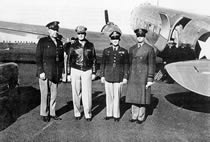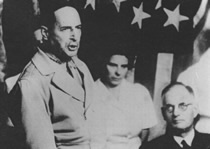
one of the fateful meetings of history
Darwin - a burning oil storage tank after a Japanese air raid, 1942.
Courtesy National Archives of Australia: A11663, PA189
'the drab, socialist politician and the colourful, conservative general'
JCPML. Records of Douglas MacArthur. Medal of Honor awarded to General MacArthur, 1942. JCPML00786/1. Original held by MacArthur Memorial Library
Both men were unstinting in their public praise of the other.
had exhibited a regard for the rights of this Government and its people, which could not have been exceeded if he had been an officer of our own army.9
For his part MacArthur had referred to Curtin as the 'heart and soul of Australia' and subsequently told Manuel Quezon, President of the embryo Philippines Commonwealth, as the latter prepared to depart from Melbourne to establish a government-in-exile in the United States, that
When I stand at the gates of Manila, I want the President of the Commonwealth at my right hand and the Prime Minister of Australia at my left.10
JCPML. Records of the Curtin Family. PM John Curtin shaking hands with General Douglas MacArthur, Sydney 8 June 1943. JCPML00376/69
General Douglas MacArthur to take command of all American army forces in the Far East
The decision to send MacArthur to Australia
It is part of the Curtin-MacArthur legend that it was at Curtin's request that MacArthur was appointed to the supreme command which brought him to Australia in March 1942. At best this is only true in a technical sense.
On 26 July 1941 President Roosevelt, having become aware of a Japanese cabinet decision to advance southward, announced the appointment of retired General Douglas MacArthur to take command of all American army forces in the Far East, including the previously separate Philippine Army. At the time, Japan, which had been at war with China for several years, relied heavily on US oil supplies but these became unavailable from August when talks broke down between the two countries. In these circumstances war between the two nations became increasingly inevitable.
During November 1941 MacArthur received substantial reinforcements from the US to help defend the Philippines. On December 7 and 8 the Japanese attack on Pearl Harbour was accompanied by assaults on Malaya and Thailand and Singapore was bombed. On 10 December the first troops came ashore in the Philippines and by early February 1942, as the situation deteriorated, there were even proposals from Quezon, approved by MacArthur, that the Philippines be given independence and neutralized by agreement between Japan and the US.11 MacArthur himself predicted a disastrous debacle if the campaign continued but Roosevelt ordered that MacArthur should resist for as long as possible, though with the final authority to determine if and when to capitulate.12 It was in this environment that it became increasingly apparent that Australia would ultimately be the prime choice as the alternative US base in the South-West Pacific.
JCPML. Records of the Curtin Family. Franklin D Roosevelt. Inscribed "For The Rt Hon John Curtin, Prime Minister of Australia From his friend Franklin D Roosevelt". JCPML00376/123
MacArthur undertook the hazardous journey from the Philippines to Darwin
In the meantime, in response to instructions from Roosevelt, MacArthur undertook the hazardous journey (see below) from the Philippines to Darwin and from there via Alice Springs and Adelaide to Melbourne, arriving on 21 March. By this time the Australian cabinet, with the backing of the Advisory War Council, had already formally agreed to MacArthur's appointment as the new Supreme Commander. However, the extent of his command was limited by a parallel decision by Roosevelt that a separate South Pacific area including New Zealand was to be placed under naval control with the commander reporting to Admiral Nimitz, Commander-in-Chief of the whole 'Pacific Ocean Area'. Both Australia and New Zealand protested their being placed in separate areas, a decision which may have been partly due to bitterness towards MacArthur in some quarters in the US Navy.15
General MacArthur's statement on arrival in Australia, 21 March 1942.
'I am glad indeed to be in immediate co-operation with the Australian soldier. I know him well from World War days, and admire him greatly. I have every confidence in the ultimate success of our joint cause...'
Courtesy National Archives of Australia: A5954, 2037/6
It was a stroke of genius sending MacArthur here (Nelson Johnson)
MacArthur's arrival in Australia
It was on 22 February, the very day of the most decisive cablegram in the Churchill-Curtin dispute over whether Australian soldiers returning from the Middle East should be diverted to Burma - and two days after Quezon had left the Philippines, that Roosevelt had ordered MacArthur also to leave, initially to proceed to Mindanao and subsequently to Australia. On 11 March, with his wife and child and a number of staff officers, MacArthur embarked on the difficult and dangerous sea voyage to Mindanao in a PT-41 Torpedo Boat (a twenty feet wide and seventy feet long vessel) and subsequently completed the ten hour air flight to Darwin landing on 17 March. After another flight to Alice Springs the party went by train to Adelaide and from there to Melbourne. A crowd of 5000 people and an honor guard of 360 Army engineers were at Melbourne's Spencer Street station on 21 March when MacArthur was officially welcomed by Army Minister Frank Forde. The arrival of a general who had already been directly involved in the military resistance to the Japanese was of great importance. In the words of the American minister to Australia, Nelson Johnson,
It was a stroke of genius sending MacArthur here ... just the thing that was needed to boost a flagging morale.16
In similar vein the Brisbane Courier Mail in a typical editorial referred to MacArthur's arrival as 'the best news Australians have had for many a day'.17
JCPML. Records of Richard Marshall. General MacArthur arrives "Somewhere in Australia", 1942. JCPML00680/1. Original held by MacArthur Memorial Library and Archives: RG 27 Series VI, Box 5 folder 6 (Photo by US Army Signal Corps).
At the official banquet the announcement was made of his Congressional Medal of Honor award.
For his part, MacArthur set the scene for future strategic and political disputes when he insisted that
No general can make something out of nothing. My success or failure will depend primarily upon the resources which the respective governments place at my disposal.18
Over the next few days MacArthur established his family and staff at the plush Menzies Hotel which was to serve as military headquarters for his first four months in Australia.
Five days after his arrival in Melbourne MacArthur flew to Canberra for his first meeting with Curtin. At a meeting of the Advisory War Council he expressed the view that the Japanese lacked the strength to invade northern Australia but could well attempt to seize air bases in New Guinea from which to launch attacks on the mainland. Strategically the first task he indicated was to secure Australia and then subsequently to provide a launching pad for a counter stroke to the Philippines.19
At the official banquet in the evening the announcement was made of his Congressional Medal of Honor award. In making this award Roosevelt was clearly seeking to counteract criticism of MacArthur for 'retreating' from the Philippines. The President was also doubtless reacting to the tension which had developed between Australia and Britain over the appointment of Richard Casey, Australia's Minister to Washington, as British Minister of State in the Middle East.20 In concluding his response at the banquet MacArthur told the audience
We shall win or we shall die, and to this end I pledge the full resources of all the mighty power of my country and all the blood of my countrymen.21
JCPML. Records of Douglas MacArthur. General MacArthur speaking at a state dinner in Canberra with PM Curtin, 194? JCPML00265/13. Original held by MacArthur Memorial Library and Archives: MML&A 9757
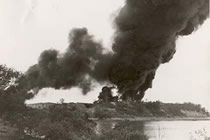
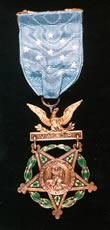
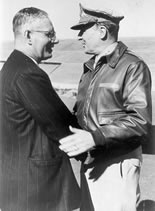
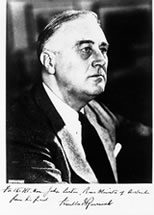
s.jpg)
